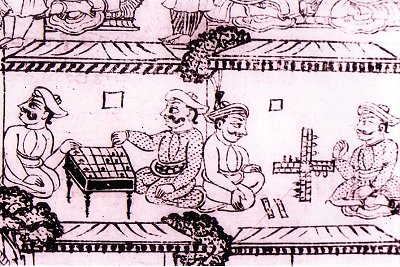
File:Men Playing Board Games.jpg
| |
This is a file from the Wikimedia Commons. Information from its description page there is shown below.
Commons is a freely licensed media file repository. You can help. |
Summary
| Description |
English: Mummadi Krishnaraja Wodeyar had the longest reign among rulers of Mysore (1799 - 1868). He had varied interests in life -- music, painting, literature -- each of which he loved and tried his hand in. He spent liberally on promotion of learning and patronized a number of scholars. He is credited with the authorship of 109 works in Kannada and Sanskrit! It was a common custom in royal courts for littérateurs to write and dedicate their works to their patrons, or to seek permission to lend his name to their writings. But, among the works attributed to Mummadi, scholars are united in identifying some Devata-Stutis (hymns in praise of Gods), a work on games and Sougandhika Parinaya (wedding of Sugandhika), a prose romance, as Mummadi's own creation.
The theme involves Lord Indra, the king of heaven. Under a curse by the sage Durvasa he is born as prince Sugandharaja in the land of Karnataka to pious parents. His childhood, youth and training for kingship are described. His several exploits to win over princess Sougandhika who was born under similar circumstances, in Kalinga form the bulk of book. There are several episodes incorporated, while Sugandharaja starts to fulfil eight conditions laid down by Sougandhika to marry her. Religion, Philosophy, Yoga, astronomy, erotics, zoology, botany, music, horse and elephant-lore, horticulture, digging of wells and lakes, in short all topics a king was supposed to study are discussed. The prince excelled in all! The book is profusely illustrated. Mummadi had started a lithograph press in the palace premises and himself was a painter. He experimented with colour pictures.
|
| Date | (1821 CE) |
| Source |
|
| Author | Mummadi Krishnaraja Wodeyar |
Licensing
The official position taken by the Wikimedia Foundation is that "faithful reproductions of two-dimensional public domain works of art are public domain, and that claims to the contrary represent an assault on the very concept of a public domain". For details, see Commons:When to use the PD-Art tag. {{ PD-Art}} template without parameter: please specify why the underlying work is public domain in both the source country and the United States
(Usage: {{PD-Art|1=|deathyear=|country=|date=}}, where parameter #1 can be PD-old-auto, PD-old-auto-1923, PD-old-100 or similar) |
|||||
![]() The categories of this image should be checked. Check them now!
The categories of this image should be checked. Check them now!
- Remove redundant categories and try to put this image in the most specific category/categories
- Remove this template by clicking here (or on the first line)
File usage on other wikis
File usage
Find out more
Through Schools Wikipedia, SOS Children has brought learning to children around the world. SOS Children believes education is an important part of a child's life. That's why we ensure they receive nursery care as well as high-quality primary and secondary education. When they leave school, we support the children in our care as they progress to vocational training or higher education. There are many ways to help with SOS Children.


